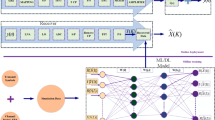Abstract
This paper proposes a hybrid channel estimation (CE) method for orthogonal frequency division multiplexing technique for use in long-term evolution technology with application suitable for highly mobile devices, such as in passenger trains. This method, termed hybrid linear (HL) estimator, combines three different CE algorithms, namely, blocked-based least square (B-LS), fast fading-based LS (FF-LS), and linear minimum mean square error (LMMSE) estimators. This proposed estimation adaptively employs a given algorithm based on the mobility condition of the receiver. The computational complexity of HL estimator is reduced nearly to the half compared with LMMSE. The performance of proposed estimator is compared with the B-LS and FF-LS in terms of throughput and mean square error (MSE). Results show that the HL performs better than the B-LS and FF-LS in both MSE and throughput. The proposed method offers a good bit-error-rate for different velocities.








Similar content being viewed by others
References
Bechir, N., & Nasreddine, M. (2014). Performance evaluation of downlink LTE system. In 1st International conference on advanced technologies for signal and image processing, pp. 492–496.
Simko, M., Mehlfuhrer, C., Wrulich, M., & Rupp, M. (2010). Doubly dispersive channel estimation with scalable complexity. In 2010 International ITG workshop on smart antennas, (pp. 251–256). Bremen: IEEE.
Gui, G., Peng, W., & Adachi, F. (2012). High-resolution compressive channel estimation for broadband wireless communication systems. International Journal of Communication Systems. doi:10.1002/dac.2483.
Fan, T., Yang, S., Wu, H., & Wang, D. (2011). Two novel channel estimation for OFDM systems by time-domain cluster discriminant analysis based on parametric channel modeling. Wireless Personal Communications, 68, 349–360. doi:10.1007/s11277-011-0455-8.
Wu, K.-G., & Wu, J.-A. (2011). Reduced-complexity decision-directed channel estimation in OFDM systems with transmit diversity. Wireless Personal Communications, 68, 175–185. doi:10.1007/s11277-011-0445-x.
Zemen, T., & Mecklenbrauker, C. F. (2005). Time-variant channel estimation using discrete prolate spheroidal sequences. IEEE Transactions on Signal Processing, 53, 3597–3607. doi:10.1109/TSP.2005.853104.
Omar, S., Ancora, A., & Slock, D. T. M. (2008). Performance analysis of general pilot-aided linear channel estimation in LTE OFDMA systems with application to simplified MMSE schemes. In 2008 IEEE 19th International symposium on personal, indoor and mobile radio communications, (pp. 1–6). Cannes: IEEE.
Leong, S.-Y., Wu, J., Olivier, J., & Xiao, C. (2003). Fast time-varying dispersive channel estimation and equalization for 8-PSK cellular system. In GLOBECOM ’03. IEEE global telecommunications conference (IEEE Cat. No.03CH37489) (pp. 2421–2425). San Francisco, CA: Ieee.
Simko, M., Mehlfuhrer, C., Zemen, T., & Rupp, M. (2011). Inter-Carrier Interference Estimation in MIMO OFDM Systems with Arbitrary Pilot Structure. In 2011 IEEE 73rd vehicular technology conference (VTC Spring) (pp. 1–5). Budapest: IEEE.
Sen, P., & Yilmaz, A. O. (2014). A low-complexity graph-based LMMSE receiver for MIMO ISI channels with M-QAM Modulation. arXiv Preprint (pp. 1–19) arXiv:1405.3057.
Bindhaiq, S., Syed-Yusof, S. K., & Hosseini, H. (2013). Performance analysis of Doppler shift effects on OFDM-based and MC-CDMA-based cognitive radios. International Journal of Communication Systems. doi:10.1002/dac.2497.
European Telecommunications Standards Institute. (2009). 3GPP TS 36.211 version 8.7.0 Release 8. 0:0–86.
Larmo, A., Lindstrom, M., Meyer, M., et al. (2009). The LTE link-layer design. IEEE Communications Magazine, 47, 52–59. doi:10.1109/MCOM.2009.4907407.
Jagannatham, A. K., & Rao, B. D. (2012). Cramer-Rao bound based mean-squared error and throughput analysis of superimposed pilots for semi-blind multiple-input multiple-output wireless channel estimation. International Journal of Communication Systems. doi:10.1002/dac.2403.
Kim, J., Park, J., & Hong, D. (2005). Performance analysis of channel estimation in OFDM systems. IEEE Signal Processing Letters, 12, 60–62. doi:10.1109/LSP.2004.839699.
Noh, M., Lee, Y., & Park, H. (2006). Low complexity LMMSE channel estimation for OFDM. IEE Proceedings on Commununications, 153, 645. doi:10.1049/ip-com:20050026.
Hung, K.-C., & Lin, D. W. (2010). Pilot-based LMMSE channel estimation for OFDM systems with Power–Delay profile approximation. IEEE Transactions on Vehicular Technology, 59, 150–159. doi:10.1109/TVT.2009.2029862.
Misans, P., & Terauds, M. (2012). CW doppler radar based land vehicle speed measurement algorithm using zero crossing and least squares method. In 2012 13th Biennial Baltic electronics conference (pp. 161–164). Tallinn, Estonia: Ieee.
Hua, J. Y., Yuan, D. H., Li, G., & Meng, L. M. (2013). Accurate estimation of Doppler shift in mobile communications with high vehicle speed. International Journal of Communication Systems. doi:10.1002/dac.2510.
At&t. (2010). LTE RF network design guidelines. AT&T Mobility Network Services Document ND-00369 Rev. 1.1 May 2010.
Zhou, B., Jiang, L., Zhao, S., & He, C. (2011). BER analysis of TDD downlink multiuser MIMO systems with imperfect channel state information. EURASIP Journal on Advances in Signal Processing, 2011, 104. doi:10.1186/1687-6180-2011-104.
Erceg, V., Hari, K. V. S., & Smith, M. S., et al. (2001). Channel models for fixed wireless applications—IEEE 802.16.3c-01/29r4. 1–36.
Acknowledgments
The authors thank the Ministry of Science and Technology, Malaysia for providing finan-cial support for this work through the eScienceFund Grant 4S105 managed by the Research Management Center, Universiti Teknologi Malaysia and we would like also thank the anonymous reviewers for their insightful comments and suggestions to improve the quality of this paper.
Author information
Authors and Affiliations
Corresponding author
Rights and permissions
About this article
Cite this article
Al-Samman, A.M., Nunoo, S., Rahman, T.A. et al. Hybrid Channel Estimation Technique with Reduced Complexity for LTE Downlink. Wireless Pers Commun 82, 1147–1159 (2015). https://doi.org/10.1007/s11277-015-2272-y
Published:
Issue Date:
DOI: https://doi.org/10.1007/s11277-015-2272-y




